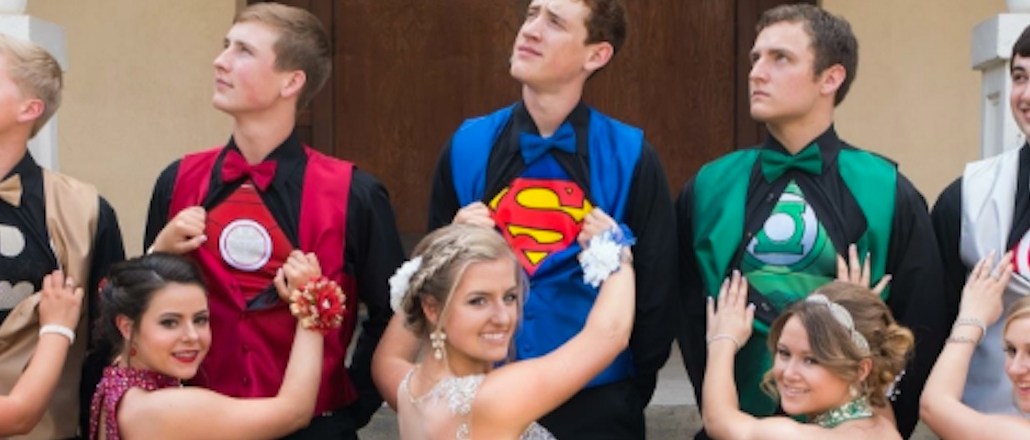
In 2012, Kaelen Walsh surprised his high school girlfriend by writing “Prom?” on 500 ping-pong balls and subsequently stuffing them in her locker. The moment she opens the locker, as well as the planning that went in beforehand, has been captured in a YouTube video with over 1.6 million views — one of the thousands of other videos across social media that document cutesy prom antics.
Dresses, tuxedos, corsages — heck, even limos — don’t cut it anymore. Teens are taking prom to a whole new level, staging elaborate “promposals” with puppies, K-pop flash mobs and personalized Snapchat geofilters. For a generation raised on social media, prom is just another event to overshare online. Brands have taken note.
“Prom today is a chance to not just seek status in your community, but social validation on the internet,” said Megan Hartman, strategy director at Red Peak Branding. “It’s yet another avenue for self-expression and creativity, and there is a huge opportunity for any brand that can facilitate this in any way.”
Men’s Wearhouse attempted to do just that recently, when it declared March 11 “National Promposal Day” and ran a massive social media campaign around it. The brand launched a custom filter on Snapchat which was made available to over 18,000 high schools across the United States and Canada, enabling students to pop the all-important question to their dates. The filter was used almost a million times.
Other brands and publishers are not far behind. Last year, Sour Patch Kids ran a competition where it asked teens to submit their promposals on Snapchat and social media; MTV launched “Promposal Mania,” a two-day celebration of prom across all its platforms. That’s not to say everyone is doing it right though. McDonald’s recently served up this dud:
When you can’t decide if you wanna go to prom or get a #BigMac #Promblems pic.twitter.com/fvPwHATzck
— McDonald’s (@McDonalds) May 6, 2016
 Just last week, Seventeen Magazine ran its second (of three) prom-themed pop-up channels on Snapchat Discover. Seventeen is not a permanent publisher on Discover, but this was the perfect theme for it to try it out, said Betsy Fast, Seventeen.com’s site director. The channel was live for 36 hours, had 6.5 million unique visitors, over 500,000 content shares and an average time of three minutes spent per user. Seventeen also ran an ad for the movie “Me Before You,” interspersed with GIFs, memes and stories like “15 prettiest prom hairstyles you can totally do yourself.”
Just last week, Seventeen Magazine ran its second (of three) prom-themed pop-up channels on Snapchat Discover. Seventeen is not a permanent publisher on Discover, but this was the perfect theme for it to try it out, said Betsy Fast, Seventeen.com’s site director. The channel was live for 36 hours, had 6.5 million unique visitors, over 500,000 content shares and an average time of three minutes spent per user. Seventeen also ran an ad for the movie “Me Before You,” interspersed with GIFs, memes and stories like “15 prettiest prom hairstyles you can totally do yourself.”
Turns out, jumping on the prom bandwagon isn’t just a way of flexing a brand’s social muscles. It’s also good business. While total spending per household on prom fell to $919 in 2015 from $1139 in 2013, promposals are becoming an increasingly important and expensive component, found Visa’s annual nationwide survey. In 2015, the survey added promposal costs to the total prom bill for the first time, finding that the average American household with teenagers spent $324 on promposing.
“Associating with prom is great business sense: In 2011 alone, it was cited as a $4 billion industry,” said Hartman. “The spend alone means it’s a great opportunity for brands.”
It makes all the more sense for some kinds of brands, namely fashion, beauty and skincare. The idea isn’t necessarily to prompt people to buy products, but also offer inspiration. Believing that its approach to prom is a natural extension of its content and conversations with customers, beauty retailer Sephora took to emerging social media app Wishbone for its prom push.
Wishbone lets users vote on their favorite choices of similar images, and Sephora shared an image of two different up-dos that could be worn to prom for users to vote on. Sephora also created a YouTube video called “3 Tips for Perfect Prom Beauty” and posted it on Facebook using gender, age and interest targeting.
“Today, the beauty journey for prom starts online, not in the shopping mall or by flipping through the pages of a teen magazine,” said Bindu Shah, vp of digital marketing at Sephora. “Brands can now create more customized content, based on what they know she is searching for and also evolve our content approach to suit each channel.”
Image via Johnny Bolinger/BN Focus Photography
More in Marketing

The case for and against organic social
Digiday has delved into the debate, weighing the arguments for and against marketers relying on organic social.

Inside Google’s latest move to postpone the cookie apocalypse
Despite Google’s (most recent) assurances that it would stick to its (newest) game plan, there has been a lot going on as of late.

While Biden signs the TikTok bill, marketers still aren’t panicking
No one seems convinced (yet) that an outright ban will happen anytime soon.





